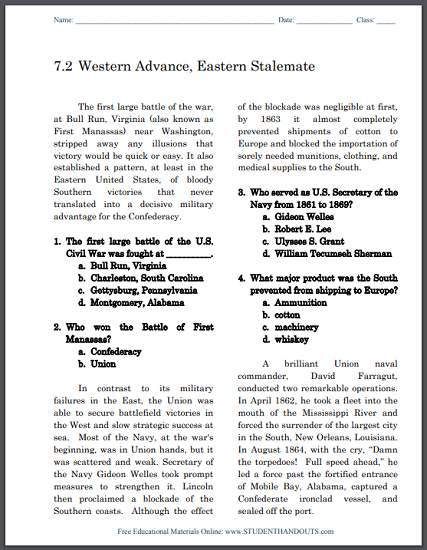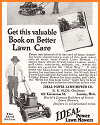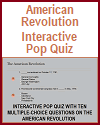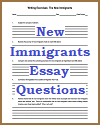| Western Advance, Eastern Stalemate Reading with Questions |
|---|
| www.studenthandouts.com ↣ American History ↣ American History Readings |
|
The first large battle of the war, at Bull Run, Virginia (also known as First Manassas) near Washington, stripped away any illusions that victory would be quick or easy. It also established a pattern, at least in the Eastern United States, of bloody Southern victories that never translated into a decisive military advantage for the Confederacy. 1. The first large battle of the U.S. Civil War was fought at __________. a. Bull Run, Virginia b. Charleston, South Carolina c. Gettysburg, Pennsylvania d. Montgomery, Alabama 2. Who won the Battle of First Manassas? a. Confederacy b. Union  In contrast to its military failures in the East, the Union was able to secure battlefield victories in the West and slow strategic success at sea. Most of the Navy, at the war's beginning, was in Union hands, but it was scattered and weak. Secretary of the Navy Gideon Welles took prompt measures to strengthen it. Lincoln then proclaimed a blockade of the Southern coasts. Although the effect of the blockade was negligible at first, by 1863 it almost completely prevented shipments of cotton to Europe and blocked the importation of sorely needed munitions, clothing, and medical supplies to the South.
In contrast to its military failures in the East, the Union was able to secure battlefield victories in the West and slow strategic success at sea. Most of the Navy, at the war's beginning, was in Union hands, but it was scattered and weak. Secretary of the Navy Gideon Welles took prompt measures to strengthen it. Lincoln then proclaimed a blockade of the Southern coasts. Although the effect of the blockade was negligible at first, by 1863 it almost completely prevented shipments of cotton to Europe and blocked the importation of sorely needed munitions, clothing, and medical supplies to the South.3. Who served as U.S. Secretary of the Navy from 1861 to 1869? a. Gideon Welles b. Robert E. Lee c. Ulysses S. Grant d. William Tecumseh Sherman 4. What major product was the South prevented from shipping to Europe? a. Ammunition b. cotton c. machinery d. whiskey A brilliant Union naval commander, David Farragut, conducted two remarkable operations. In April 1862, he took a fleet into the mouth of the Mississippi River and forced the surrender of the largest city in the South, New Orleans, Louisiana. In August 1864, with the cry, "Damn the torpedoes! Full speed ahead," he led a force past the fortified entrance of Mobile Bay, Alabama, captured a Confederate ironclad vessel, and sealed off the port. 5. During the U.S. Civil War, what was the largest city in the American South? a. Biloxi, Mississippi b. Charleston, South Carolina c. Gatlinburg, Tennessee d. New Orleans, Louisiana 6. Who famously shouted, "Damn the torpedoes! Full speed ahead," as he charged into Mobile Bay, Alabama? In the Mississippi Valley, the Union forces won an almost uninterrupted series of victories. They began by breaking a long Confederate line in Tennessee, thus making it possible to occupy almost all the western part of the state. When the important Mississippi River port of Memphis was taken, Union troops advanced some 320 kilometers into the heart of the Confederacy. With the tenacious General Ulysses S. Grant in command, they withstood a sudden Confederate counterattack at Shiloh, on the bluffs overlooking the Tennessee River. Those killed and wounded at Shiloh numbered more than 10,000 on each side, a casualty rate that Americans had never before experienced. But it was only the beginning of the carnage. 7. Over ten thousand soldiers were killed at what Tennessee battle? a. First Manassas b. Gettysburg c. Shiloh d. Thermopylae In Virginia, by contrast, Union troops continued to meet one defeat after another in a succession of bloody attempts to capture Richmond, the Confederate capital. The Confederates enjoyed strong defense positions afforded by numerous streams cutting the road between Washington and Richmond. Their two best generals, Robert E. Lee and Thomas J. ("Stonewall") Jackson, both far surpassed in ability their early Union counterparts. In 1862 Union commander George McClellan made a slow, excessively cautious attempt to seize Richmond. But in the Seven Days' Battles between June 25 and July 1, the Union troops were driven steadily backward, both sides suffering terrible losses. 8. What city served as the capital of the Confederate States of America? a. Atlanta, Georgia b. Charleston, South Carolina c. Richmond, Virginia d. Washington, D.C. 9. Who led U.S. troops in the Seven Days' Battles? a. David Farragut b. George McClellan c. Gideon Welles d. Thomas "Stonewall" Jackson After another Confederate victory at the Second Battle of Bull Run (or Second Manassas), Lee crossed the Potomac River and invaded Maryland. McClellan again responded tentatively, despite learning that Lee had split his army and was heavily outnumbered. The Union and Confederate Armies met at Antietam Creek, near Sharpsburg, Maryland, on September 17, 1862, in the bloodiest single day of the war: More than 4,000 died on both sides and 18,000 were wounded. Despite his numerical advantage, however, McClellan failed to break Lee's lines or press the attack, and Lee was able to retreat across the Potomac with his army intact. As a result, Lincoln fired McClellan. 10. What was the bloodiest single day of the U.S. Civil War? 11. Why did commander-in-Chief Abraham Lincoln fire General McClellan? Although Antietam was inconclusive in military terms, its consequences were nonetheless momentous. Great Britain and France, both on the verge of recognizing the Confederacy, delayed their decision, and the South never received the diplomatic recognition and the economic aid from Europe that it desperately sought. 12. What two European countries decided against granting diplomatic recognition to the Confederacy following Antietam? Antietam also gave Lincoln the opening he needed to issue the preliminary Emancipation Proclamation, which declared that as of January 1, 1863, all slaves in states rebelling against the Union were free. In practical terms, the proclamation had little immediate impact; it freed slaves only in the Confederate states, while leaving slavery intact in the border states. Politically, however, it meant that in addition to preserving the Union, the abolition of slavery was now a declared objective of the Union war effort. 13. What presidential document granted freedom to slaves living within the Confederacy? The final Emancipation Proclamation, issued January 1, 1863, also authorized the recruitment of African Americans into the Union Army, a move abolitionist leaders such as Frederick Douglass had been urging since the beginning of armed conflict. Union forces already had been sheltering escaped slaves as "contraband of war," but following the Emancipation Proclamation, the Union Army recruited and trained regiments of African-American soldiers that fought with distinction in battles from Virginia to the Mississippi. About 178,000 African Americans served in the U.S. Colored Troops, and 29,500 served in the Union Navy. 14. Frederick Douglass argued strongly against allowing African Americans to fight for the Union. a. True b. False 15. About 178,000 African Americans served in the U.S. Colored Troops, and 29,500 served in the Union Navy. How many served in total? Despite the political gains represented by the Emancipation Proclamation, however, the North's military prospects in the East remained bleak as Lee's Army of Northern Virginia continued to maul the Union Army of the Potomac, first at Fredericksburg, Virginia, in December 1862 and then at Chancellorsville in May 1863. But Chancellorsville, although one of Lee's most brilliant military victories, was also one of his most costly. His most valued lieutenant, General "Stonewall" Jackson, was mistakenly shot and killed by his own men. 16. General "Stonewall" Jackson was killed by friendly fire at what battle, in 1863? a. Chancellorsville b. Fredericksburg c. Gettysburg d. Second Manassas 17. The Emancipation Proclamation was adopted as part of Lincoln's war strategy. How might declaring freedom for slaves living in the Confederacy help the Union war effort? Answer Key: 1. A - Bull Run, Virginia; 2. A - Confederacy; 3. A - Gideon Welles; 4. B - cotton; 5. D - New Orleans, Louisiana; 6. David Farragut; 7. C - Shiloh; 8. C - Richmond, Virginia; 9. B - George McClellan; 10. Battle of Antietam (September 17, 1862); 11. Over defeat at Antietam and failure to break Lee's lines or press the attack; 12. Great Britain and France; 13. Emancipation Proclamation; 14. B - False; 15. About 207,500; 16. A - Chancellorsville; 17. Answers will vary, but should include the Union's hope that slaves would rebel, thereby distracting Southern governments and troops. Click here to print this worksheet. |
 |  |  |  |  |  |
| www.studenthandouts.com ↣ American History ↣ American History Readings |








